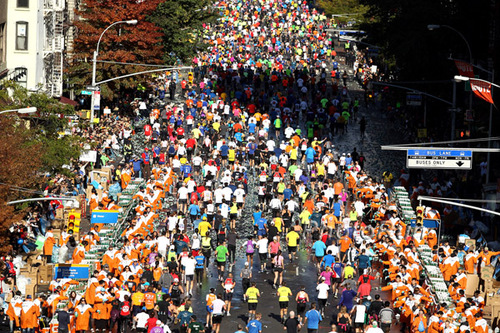I more than suspect that New York City is deeply conscious of being challenged – that it feels the millibars of pressure exerted by Hurricane Sandy not only in the visible destruction left behind by the rampaging natural turbine, but in the unseen measure of its famously elastic psyche, what Robert Greenhut, Woody Allen’s producer, called “a certain kind of vibrancy and tone that you can’t get elsewhere.”
It is that vibrancy that attracts people by the millions to the teeming metropolis, especially so during its annual marathon week when the entire panoply of culture, energy and diversity is laid out in mile and kilometer-marked precision.
There is never a good time for a catastrophe like Sandy to occur. City services and personnel will be exhausted and stretched to the breaking point. Priorities like clearing debris, returning people to their homes, and opening the city’s vital transportation links will be manifest. But in its own paradoxical way, could this particular time, marathon week, be any more propitious?
Recall that when the five-borough marathon was first conceived in 1976, New York was both riddled with crime and in the midst of a fiscal meltdown. The federal government had told them to go fly a kite, not to look for help out of Washington. So as the five-borough course founders considered the possibilities before them, there was real fear of how runners might be treated in the less affluent neighborhoods along the route.
![NYCMfans]()
“You can do it!”
Instead, what the city-wide marathon revealed in that Bicentennial year was the commonality of man when the outer garb of privilege was stripped away, and pure effort and struggle were put on display. Everyone related. Everyone got it. Neither the city, nor the sport of marathoning has ever been the same since.
In the aftermath of 9-11 when the city’s psychic wound was much deeper than it is today, the marathon arrived in prideful defiance of the terrorists’ desires, knitting the city together in a muscular display of remembrance and resurrection.
New Yorkers are infamous for their no-eye-contact, “you talkin’ to me?” insularity. Yet, they are equally renowned for their willingness to pull relentlessly together in times of crisis. Well, here’s a crisis for you. This Sunday in New York City remnants of Sandy’s destruction will still be apparent, both at street level and on television screens around the world. But as it has done in the past, the sheer humanity of New York City and its marathon will serve as a moving metaphor to the power of community and the will to overcome.
END




















